The AMD Threadripper 2990WX 32-Core and 2950X 16-Core Review
by Dr. Ian Cutress on August 13, 2018 9:00 AM ESTHEDT Benchmarks: System Tests
Our System Test section focuses significantly on real-world testing, user experience, with a slight nod to throughput. In this section we cover application loading time, image processing, simple scientific physics, emulation, neural simulation, optimized compute, and 3d model development, with a combination of readily available and custom software. For some of these tests, the bigger suites such as PCMark do cover them (we publish those values in our office section), although multiple perspectives is always beneficial. In all our tests we will explain in-depth what is being tested, and how we are testing.
Application Load: GIMP 2.10.4
One of the most important aspects about user experience and workflow is how fast does a system respond. A good test of this is to see how long it takes for an application to load. Most applications these days, when on an SSD, load fairly instantly, however some office tools require asset pre-loading before being available. Most operating systems employ caching as well, so when certain software is loaded repeatedly (web browser, office tools), then can be initialized much quicker.
In our last suite, we tested how long it took to load a large PDF in Adobe Acrobat. Unfortunately this test was a nightmare to program for, and didn’t transfer over to Win10 RS3 easily. In the meantime we discovered an application that can automate this test, and we put it up against GIMP, a popular free open-source online photo editing tool, and the major alternative to Adobe Photoshop. We set it to load a large 50MB design template, and perform the load 10 times with 10 seconds in-between each. Due to caching, the first 3-5 results are often slower than the rest, and time to cache can be inconsistent, we take the average of the last five results to show CPU processing on cached loading.
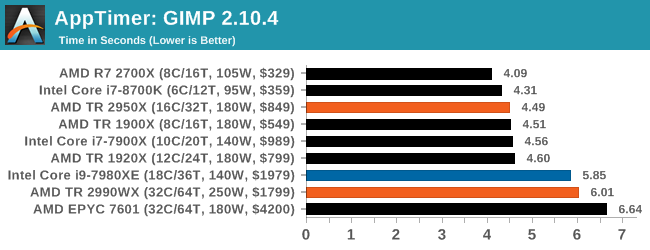
This benchmark has neatly fallen into two categories: mostly lower core count processors on one side, and the high-end desktop on the other. The 1920X and 2950X are quick, while Intel’s 18-core and the 32-core parts are slower. This is likely due to the bigger differential in single core performance, however I suspect that some of the memory latency might also be a factor here.
FCAT: Image Processing
The FCAT software was developed to help detect microstuttering, dropped frames, and run frames in graphics benchmarks when two accelerators were paired together to render a scene. Due to game engines and graphics drivers, not all GPU combinations performed ideally, which led to this software fixing colors to each rendered frame and dynamic raw recording of the data using a video capture device.
The FCAT software takes that recorded video, which in our case is 90 seconds of a 1440p run of Rise of the Tomb Raider, and processes that color data into frame time data so the system can plot an ‘observed’ frame rate, and correlate that to the power consumption of the accelerators. This test, by virtue of how quickly it was put together, is single threaded. We run the process and report the time to completion.

All our systems perform similarly, however Intel’s faster single threaded performance puts its processors in the lead here. The EPYC 7601 sits out back with its low single core frequency.
3D Particle Movement v2.1: Brownian Motion
Our 3DPM test is a custom built benchmark designed to simulate six different particle movement algorithms of points in a 3D space. The algorithms were developed as part of my PhD., and while ultimately perform best on a GPU, provide a good idea on how instruction streams are interpreted by different microarchitectures.
A key part of the algorithms is the random number generation – we use relatively fast generation which ends up implementing dependency chains in the code. The upgrade over the naïve first version of this code solved for false sharing in the caches, a major bottleneck. We are also looking at AVX2 and AVX512 versions of this benchmark for future reviews.
For this test, we run a stock particle set over the six algorithms for 20 seconds apiece, with 10 second pauses, and report the total rate of particle movement, in millions of operations (movements) per second.
3DPM v2.1 can be downloaded from our server: 3DPMv2.1.rar (13.0 MB)
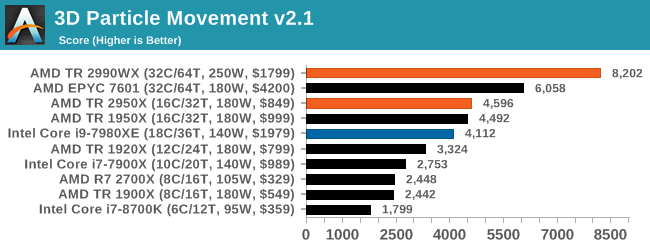
It would appear that 3DPM loves threads and frequency, with the top four spots going to AMD. Even last generation’s 16-core outperforms Intel’s 18-core in this test using non-AVX instructions. An interesting comparison here is between the 2990WX and the EPYC 7601 – the extra frequency on the consumer processor helps drive an extra 30%+ performance.
Dolphin 5.0: Console Emulation
One of the popular requested tests in our suite is to do with console emulation. Being able to pick up a game from an older system and run it as expected depends on the overhead of the emulator: it takes a significantly more powerful x86 system to be able to accurately emulate an older non-x86 console, especially if code for that console was made to abuse certain physical bugs in the hardware.
For our test, we use the popular Dolphin emulation software, and run a compute project through it to determine how close to a standard console system our processors can emulate. In this test, a Nintendo Wii would take around 1050 seconds.
The latest version of Dolphin can be downloaded from https://dolphin-emu.org/

Dolphin is typically governed by single threaded performance, so Intel sits at the front here again, although having the R7 2700X at the end seems a little odd. On the off chance that this is a freak result, I should run this test again. However on the second generation TR parts, the higher clock frequency of the 2950X puts it ahead of the 2990WX by a good 20 seconds.
DigiCortex 1.20: Sea Slug Brain Simulation
This benchmark was originally designed for simulation and visualization of neuron and synapse activity, as is commonly found in the brain. The software comes with a variety of benchmark modes, and we take the small benchmark which runs a 32k neuron / 1.8B synapse simulation, equivalent to a Sea Slug.

Example of a 2.1B neuron simulation
We report the results as the ability to simulate the data as a fraction of real-time, so anything above a ‘one’ is suitable for real-time work. Out of the two modes, a ‘non-firing’ mode which is DRAM heavy and a ‘firing’ mode which has CPU work, we choose the latter. Despite this, the benchmark is still affected by DRAM speed a fair amount.
DigiCortex can be downloaded from http://www.digicortex.net/
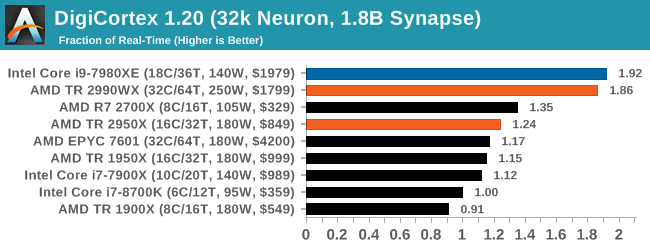
Here the quad-core processors with lots of cores have a good lead out front, however the low frequency of the EPYC 7601 puts it down the list. It would seem that the extra latency bi-modal cores in the 2990WX have not done too much damage, although you would feel that there might be extra performance to gain.
y-Cruncher v0.7.6: Microarchitecture Optimized Compute
I’ve known about y-Cruncher for a while, as a tool to help compute various mathematical constants, but it wasn’t until I began talking with its developer, Alex Yee, a researcher from NWU and now software optimization developer, that I realized that he has optimized the software like crazy to get the best performance. Naturally, any simulation that can take 20+ days can benefit from a 1% performance increase! Alex started y-cruncher as a high-school project, but it is now at a state where Alex is keeping it up to date to take advantage of the latest instruction sets before they are even made available in hardware.
For our test we run y-cruncher v0.7.6 through all the different optimized variants of the binary, single threaded and multi-threaded, including the AVX-512 optimized binaries. The test is to calculate 250m digits of Pi, and we use the single threaded and multi-threaded versions of this test.
Users can download y-cruncher from Alex’s website: http://www.numberworld.org/y-cruncher/
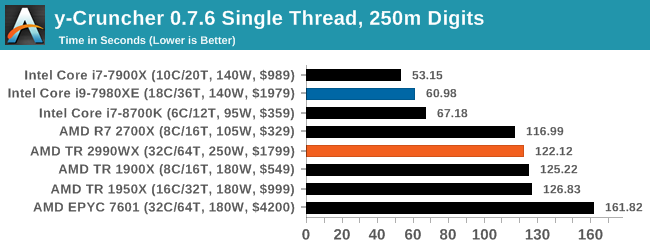

The Intel software is heavily optimized for AVX2 or AVX512, which sows in our single threaded test, however when we pile on the cores and the memory channels, both of AMD’s 32-core parts give the Core i9 a run for its money.
Agisoft Photoscan 1.3.3: 2D Image to 3D Model Conversion
One of the ISVs that we have worked with for a number of years is Agisoft, who develop software called PhotoScan that transforms a number of 2D images into a 3D model. This is an important tool in model development and archiving, and relies on a number of single threaded and multi-threaded algorithms to go from one side of the computation to the other.
In our test, we take v1.3.3 of the software with a good sized data set of 84 x 18 megapixel photos and push it through a reasonably fast variant of the algorithms, but is still more stringent than our 2017 test. We report the total time to complete the process.
Agisoft’s Photoscan website can be found here: http://www.agisoft.com/

Photoscan shows a good spread, however the 2990WX is sitting at the back as it has cores that cannot access memory quick enough – the EPYC 7601 with double the memory channels operates almost 500 seconds (20%+) quicker, so if the 2990WX had extra memory, I’m sure it would shoot up the list.
Interesting the TR 1950X sits top, above the TR 2950X which has better cache latency and higher frequency in all scenarios. That’s a head scratcher.


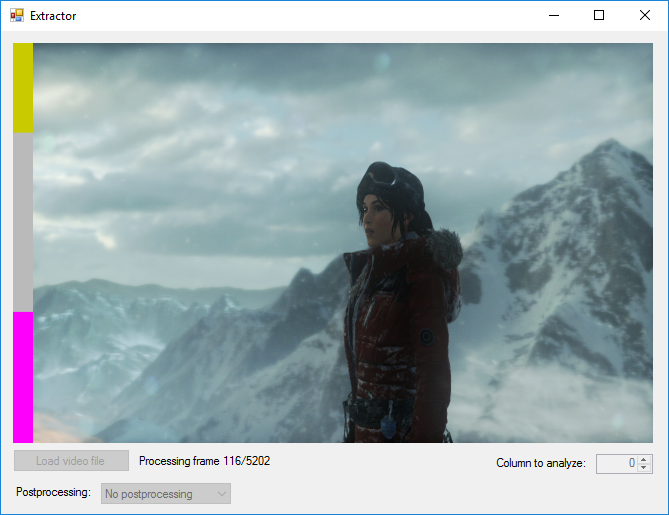









171 Comments
View All Comments
3DVagabond - Wednesday, August 15, 2018 - link
When did you switch to this new benchmark suite?Lord of the Bored - Wednesday, August 15, 2018 - link
Still writing...mukiex - Friday, August 17, 2018 - link
Looks like it's no longer a problem! They deleted all those pages.GreenReaper - Saturday, August 18, 2018 - link
They're back again now.abufrejoval - Wednesday, August 15, 2018 - link
Separating CPU (and GPU) cores from their memory clearly doesn't seem sustainable going forward.That's why I find the custom chip did for the chinese console so interesting: If they did an HBM variant, perhaps another with 16 or even 32GB per SoC, they'd use the IF mostly for IPC/non-local memory access and the chance of using GPGPU compute for truly parallel algorithms would be much bigger as the latency of context switches between CPU and GPU code would be minimal with both using the same physical memory space.
They might still put ordinary RAM or NV-RAM somewhere to the side as secondary storage, so it looks a little like Knights Landing.
IF interconnects might be a little longer, really long when you scale beyond what you can fit on a single board and probably something where optical interconnects would be better (once you got them...)
I keep having visions of plenty of such 4x boards swimming immersed in a tank of this "mineral oil" stuff that evidently has little to do with oil but allows so much more density and could run around those chips 'naked'.
Alaa - Wednesday, August 15, 2018 - link
I do not think that testing only a single tool at a time is a good benchmark for such high core count architecture. These cores need concurrent workloads to showcase their real power.csell - Thursday, August 16, 2018 - link
Can somebody please tell me the difference between the ASUS ROG Zenith Extreme motherboard rev 2 used here and the old ASUS ROG Zenith Extreme motherboard. I can't find any information about the rev 2 somewhere else?UnNameless - Friday, August 17, 2018 - link
I also want to know that. I have the "rev 1" Asus rog zenith extreme and can't find any difference.spikespiegal - Friday, August 17, 2018 - link
Companies buy PC's to run applications and don't care about memory timing, CPU's, clock speed or any other MB architecture. They only care about the box on the desk to run applications and ROI, as they should. AMD has historically only made a dent in the low end desktop market because Intel has this funny habit of not letting chip prices depreciate much below $200. AMD does, so they occupy the discount desktop market because when you buy 10,000 general purpose workstations saving $120 per box is a big chunk of change.I'm looking at the benchmark tests and all I'm seeing is the AMD chips doing well in mindless rendering and other synthetic desktop tasks no one outside multimedia would care about. The i7 holds it's own in too many complex application tests, which proves that once again per core efficacy is all that matters and AMD can't alter the reality of this. Where is the VMware host / mixed guest application benchmark consisting of Exchange, SQL, RDS, file services, AD and other? You know, those things that run corporate commerce and favor high core efficacy? Nobody runs bare metal servers anymore, and nobody reputable builds their own servers.
Dragonrider - Friday, August 17, 2018 - link
Ian, are you going to test PBO performance with these processors (I know, it was probably not practical while you were on the road)? Some questions popped up in my mind. Can PBO be activated when the processor in partial mode (i.e. 1/2 mode or game mode in the case of the 2990)? Also What does the power consumption and performance look like in those partial modes for different application sets with and without PBO? I know that represents a lot of testing, but on the surface, the 2990 looks like it could be a really nice all-round processor if one were willing to do some mode switching. It seems like it should perform pretty close to the 2950 in game mode and 1/2 mode and you have already established that it is a rendering beast in full mode. Bottom line, I think the testing that has been published so far only scratches the surface of what this processor may be capable of.